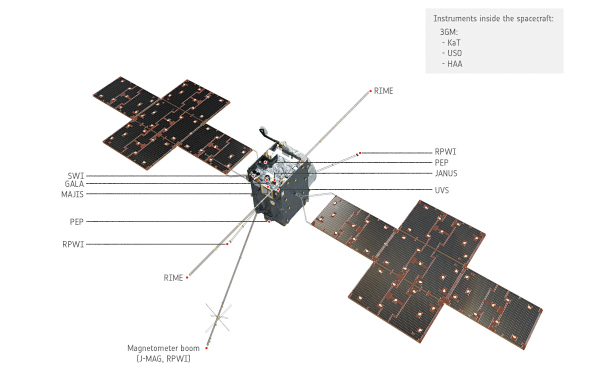| JUICE Payload |
| JANUS - Camera system |
An optical camera to study global, regional and local morphology and processes on the moons, and to perform mapping of the clouds on Jupiter.
JANUS will have 13 filters, a 1.3 degree field of view, and spatial resolution up to 2.4 m on Ganymede and about 10 km at Jupiter. |
| Principal Investigator: |
P. Palumbo, Università degli Studi di Napoli "Parthenope", Italy |
| Lead Funding Agency: |
ASI, Italy |
|
| |
| MAJIS - Moons and Jupiter Imaging Spectrometer |
A hyper-spectral imaging spectrometer for observing tropospheric cloud features and minor species on Jupiter and for the characterisation of ices and minerals on the surfaces of icy moons.
MAJIS will cover the visible and infrared wavelengths from 0.4 to 5.7 microns, with spectral resolution of 3-7 nm. The spatial resolution will be up to 25 m on Ganymede and about 100 km on Jupiter. |
| Principal Investigator: |
F. Poulet, Institut d'Astrophysique Spatiale, France |
| Lead Funding Agency: |
CNES, France |
|
| |
| UVS - UV imaging Spectrograph |
A UV spectrometer to characterise the composition and dynamics of the exospheres of the icy moons, to study the Jovian aurorae, and to investigate the composition and structure of the upper atmosphere. The instrument will perform both nadir observations and solar and stellar occultation sounding.
UVS will cover the wavelength range 55-210 nm with spectral resolution of <0.6 nm. Spatial resolution will reach 0.5 km at Ganymede and up to 250 km at Jupiter. |
| Principal Investigator: |
R. Gladstone, Southwest Research Institute, USA |
| Lead Funding Agency: |
NASA, USA |
|
| |
| SWI - Sub-millimeter Wave Instrument |
A sub-millimeter wave instrument to investigate the temperature structure, composition and dynamics of Jupiter's stratosphere and troposphere, and the exospheres and surfaces of the icy moons.
SWI is a heterodyne spectrometer using a 30 cm antenna and working in two spectral ranges 1080-1275 GHz and 530-601 GHz with spectral resolving power of ~107. |
| Principal Investigator: |
P. Hartogh, Max-Planck-Institut für Sonnensystemforschung, Germany |
| Lead Funding Agency: |
DLR, Germany |
|
| |
| GALA - GAnymede Laser Altimeter |
A laser altimeter for studying the tidal deformation of Ganymede and the morphology and topography of the surfaces of the icy moons.
GALA will have a 20 m spot size and 0.1 m vertical resolution at 200 km. |
| Principal Investigator: |
H. Hussmann, DLR, Institut für Planetenforschung, Germany |
| Lead Funding Agency: |
DLR, Germany |
|
| |
| RIME - Radar for Icy Moon Exploration |
An ice penetrating radar to study the subsurface structure of the icy moons down to 9 km depth with vertical resolution of up to 30 m in ice.
RIME will work at a central frequency of 9 MHz (1 and 3 MHz bandwidth) and will use a 16 m antenna. |
| Principal Investigator: |
L. Bruzzone, Università degli Studi di Trento, Italy |
| Lead Funding Agency: |
ASI, Italy |
|
| |
| J-MAG - A magnetometer instrument for JUICE |
A magnetometer to characterise the Jovian magnetic field, its interaction with the internal magnetic field of Ganymede, and to study subsurface oceans of the icy moons.
The instrument will use fluxgates (inbound and outbound) sensors mounted on a boom. |
| Principal Investigator: |
M. Dougherty, Imperial College London, United Kingdom |
| Lead Funding Agency: |
UKSA, United Kingdom |
|
| |
| PEP - Particle Environment Package |
A plasma package with sensors to characterise the plasma environment in the Jovian system.
PEP will measure density and fluxes of positive and negative ions, electrons, exospheric neutral gas, thermal plasma and energetic neutral atoms in the energy range from <0.001 eV to >1 MeV with full angular coverage. The composition of the moons' exospheres will be measured with a resolving power of more than 1000. |
| Principal Investigator: |
S. Barabash, Swedish Institute of Space Physics (Institutet för rymdfysik, IRF), Kiruna, Sweden |
| Lead Funding Agency: |
SNSB, Sweden |
|
| |
| RPWI - Radio & Plasma Wave Investigation |
A radio plasma wave instrument to characterise the radio emission and plasma environment of Jupiter and its icy moons.
RPWI will be based on four experiments, GANDALF, MIME, FRODO, and JENRAGE. It will use a set of sensors, including two Langmuir probes to measure DC electric field vectors up to a frequency of 1.6 MHz and to characterize thermal plasma and medium- and high-frequency receivers, and antennas to measure electric and magnetic fields in radio emission in the frequency range 80 kHz- 45 MHz. |
| Principal Investigator: |
J.-E. Wahlund, Swedish Institute of Space Physics (Institutet för rymdfysik, IRF), Uppsala, Sweden |
| Lead Funding Agency: |
SNSB, Sweden |
|
| |
| 3GM - Gravity & Geophysics of Jupiter and Galilean Moons |
A radio science package comprising a Ka transponder and an ultrastable oscillator.
3GM will be used to study the gravity field - up to degree 10 - at Ganymede and the extent of internal oceans on the icy moons, and to investigate the structure of the neutral atmospheres and ionospheres of Jupiter (0.1 - 800 mbar) and its moons. |
| Principal Investigator: |
L. Iess, Università di Roma "La Sapienza", Italy |
| Lead Funding Agency: |
ASI, Italy |
|
| |
| PRIDE - Planetary Radio Interferometer & Doppler Experiment |
| PRIDE will use the standard telecommunication system of the JUICE spacecraft and VLBI - Very Long Baseline Interferometry - to perform precise measurements of the spacecraft position and velocity to investigate the gravity fields of Jupiter and the icy moons. |
| Principal Investigator: |
L. Gurvits, Joint Institute for VLBI in Europe, The Netherlands |
| Lead Funding Agency: |
NWO and NSO, The Netherlands |
|

